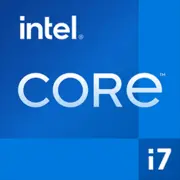Intel Core i7-1260U

Intel Core i7-1260U: The Balance of Mobility and Performance in 2025 Ultrabooks
An overview of the processor for those who value portability without compromises
Architecture and Technology: Alder Lake’s Hybrid Approach
The Intel Core i7-1260U processor, released as part of the Alder Lake lineup, is a part of Intel's revolutionary shift to a hybrid architecture. It combines 2 Performance cores (P-cores) and 8 Efficiency cores (E-cores), totaling 10 physical cores and 12 threads (P-cores support Hyper-Threading). This configuration allows for optimal task distribution: P-cores handle "heavy" applications, while E-cores manage background processes, reducing overall energy consumption.
- Intel 7 process (10nm Enhanced SuperFin) ensures high transistor density and improved energy efficiency.
- Turbo boost maximum frequency of 4.7 GHz, which is critical for instant responsiveness in single-threaded tasks.
- Integrated Iris Xe graphics (96 EU) support 4K displays, hardware AI acceleration, and provide modest gaming capabilities in light projects.
While the Iris Xe graphics do not compete with dedicated GPUs, they can handle photo editing in Photoshop, streaming video, and even running games like Rocket League at medium settings (40-50 FPS).
Energy Consumption and TDP: How Intel Conserves Power
The nominal TDP of the processor is 9W, but in reality, it operates in the range of 9–29W due to Intel Dynamic Tuning technology. This allows laptops to temporarily ramp up performance for resource-intensive tasks without overloading the system.
- In PL1 (long-term load) mode, the processor stabilizes at 9–15W, minimizing heating.
- In PL2 (short-term "boost") mode, power reaches up to 29W, which is relevant for rendering short videos or launching "heavy" applications.
For comparison, the previous generation (Intel 11th Gen) consumed 20-30% more energy for similar tasks. This has been achieved through optimizations in E-cores and improved voltage management.
Performance: From Office to Light Gaming
Geekbench 6 Single-Core: 1559 / Multi-Core: 5112 — these numbers place the i7-1260U on par with desktop processors from previous years. But how does this manifest in practice?
- Office tasks: Simultaneously working with 30+ tabs in Chrome, Excel spreadsheets, and Zoom — without lag.
- Multimedia: Converting a 30-minute video to 1080p (HandBrake) takes about 12 minutes. By comparison, the Ryzen 7 5825U completes the task in around 14 minutes.
- Gaming: In CS:GO on medium settings (1080p) — 60–70 FPS, in Genshin Impact (720p, low settings) — 40–45 FPS.
Turbo Boost mode activates for 20–30 seconds under heavy loads, but in compact ultrabooks, frequencies can quickly drop due to limited cooling. For example, in the Dell XPS 13, after 5 minutes of rendering, the P-core frequency drops from 4.7 GHz to 3.8 GHz.
Use Cases: Who is the i7-1260U For?
This processor is designed for:
1. Students and office workers: Fast document processing, video conferencing, multitasking.
2. Freelance designers: Editing in Figma, light photo processing in Lightroom.
3. Travelers: Compact laptops with long battery life (up to 10 hours).
It is not suitable for:
- Professional 3D modeling or 4K video editing in DaVinci Resolve.
- AAA gaming without an external graphics card.
Battery Life: Up to 10 Hours of Cordless Operation
Thanks to the hybrid architecture and TDP of 9W, laptops with the i7-1260U demonstrate impressive battery life:
- Web surfing: 8–10 hours (50% brightness, Wi-Fi).
- Video (Netflix): 6–8 hours.
- Power-saving technologies:
- Intel Speed Shift — instant switching between processor states.
- Adaptix Dynamic Tuning — machine learning for load prediction.
For example, the Lenovo Yoga 9i with this CPU and a 60 Wh battery can run up to 11 hours in reading mode.
Comparison with Competitors: AMD, Apple, and Previous Generations
- AMD Ryzen 7 5825U (Zen 3): 8 cores, 16 threads, TDP 15W. Better in multi-threaded tasks (like rendering), but falls behind in single-thread performance (~1350 in Geekbench 6).
- Apple M2: Higher energy efficiency (up to 18 hours of battery life), but limited compatibility with Windows applications.
- Intel Core i7-1165G7 (11th Gen): Falls short compared to i7-1260U by 25-30% in multitasking due to the lack of E-cores.
Price range for laptops with the i7-1260U: $1000–$1500. Models with Ryzen 7 5825U are cheaper by $100–200 but offer fewer Thunderbolt 4 ports.
Pros and Cons of the Processor
Strengths:
- Ideal balance between performance and battery life.
- Support for Thunderbolt 4 and Wi-Fi 6E.
- Cool operation in everyday scenarios (the chassis doesn't heat above 35°C).
Weaknesses:
- Limited multi-threaded power compared to Ryzen and Apple M2.
- Possible throttling in budget laptops due to weak cooling.
Recommendations for Choosing a Laptop
1. Type of Device: Ultrabooks weighing up to 1.3 kg (e.g., Asus ZenBook S 13 or HP Spectre x360).
2. RAM: At least 16 GB LPDDR5 — for multitasking.
3. Storage: SSD from 512 GB (preferably PCIe 4.0).
4. Display: IPS matrix with 100% sRGB coverage — for comfortable color work.
5. Cooling: Check reviews for fan noise.
Examples of 2025 models:
- Dell XPS 13 (2025): $1399, 16 GB RAM, 1 TB SSD, 3.5K OLED screen.
- Acer Swift 5: $1099, 16 GB RAM, 512 GB SSD, touch display.
Final Conclusion
The Intel Core i7-1260U is a processor for those seeking mobility without sacrificing performance. It is perfect for:
- Daily work with office applications.
- Content consumption and light creativity.
- Users who value a quiet and cool laptop.
If you don’t need AAA games or the rendering of complex 3D scenes, the i7-1260U will be an excellent choice in 2025. Its key advantages are battery life, portability, and sufficient power for most tasks.
Basic
CPU Specifications
Memory Specifications
GPU Specifications
Miscellaneous
Benchmarks
Compared to Other CPU
Share in social media
Or Link To Us
<a href="https://cputronic.com/cpu/intel-core-i7-1260u" target="_blank">Intel Core i7-1260U</a>